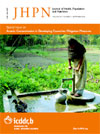
|
The Journal of Health, Population and Nutrition
icddr,b
ISSN: 1606-0997
EISSN: 1606-0997
Vol. 23, No. 3, 2005, pp. 275-281
|
 Bioline Code: hn05035
Bioline Code: hn05035
Full paper language: English
Document type: Research Article
Document available free of charge
|
|
|
The Journal of Health, Population and Nutrition, Vol. 23, No. 3, 2005, pp. 275-281
| en |
A Comparison of Two Systems for Chlorinating Water in Rural Honduras
Henderson, Amy K.; Sack, R. Bradley & Toledo, Erick
Abstract
This study investigated a small subset of the two community water-disinfection systems - hypochlorinators and tablet feeders - in rural Honduras. Levels of residual chlorine were assessed at three locations within the distribution system: the tank, the proximal house, and the distal house. The levels of residual chlorine were compared with the standard guidelines set by the Pan American Health Organization and the Inter-national Rural Water Association for potable water that require a minimum of 1.0 (tank), 0.5 (proximal house), and 0.2 (distal house) ppm for each location. The levels of residual chlorine were also compared across systems, e.g. hypochlorinators to tablet feeders. At the tank and proximal house, tablet feeders had significantly higher mean values for levels of residual chlorine (measured in ppm) than hypochlorinators (tank: 1.20 vs 0.67; proximal house: 0.44 vs 0.32, p<0.001 for both) with no significant difference at the distal house (0.16 vs 0.16). At the tank and proximal house, tablet feeders were more likely to meet recommended standards than hypochlorinators (90.3% vs 13.3%, p<0.0001 and 41.3% vs 23.7%,p<0.0001) with a smaller difference seen at the distal house (30.6% vs 27.1%, p=0.24). The apparent dichotomy in chlorine levels of tablet feeders (e.g. between tank/proximal house and distal house) is discussed. The results suggest that tablet feeders may be more effective than hypochlorinators in supplying clean water in rural, resource-poor settings and possibly serve as an alternative technology for water disinfection. Further research on techniques for empowering and building capacity within community water boards will help organize and introduce sustainable water systems in developing countries.
Keywords
Drinking-water; Chlorine; Diarrhoea; Water supply; Water quality; Water microbiology; Observational studies; Honduras
|
| |
© Copyright 2005 - ICDDR,B: Centre for Health and Population Research
Alternative site location: http://www.jhpn.net
|
|
